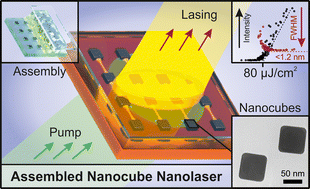2D regular nanostructures for lasing and sensing applications - LaSensA
Our study on nanolasers performed within a project by partners Kaunas University of Technology (KTU), Lithuania and National Institute for Materials Science (NIMS), Japan, has achieved significant international acclaim. The research, detailed in the article "Lasing in an assembled array of silver nanocubes" published in Nanoscale Horizons, introduces a novel approach to developing plasmonic nanolasers. The innovative work focuses on an SLR-based (surface lattice resonance) nanolaser created using an assembled array of silver nanocubes. When combined with the laser dye pyrromethene-597, the device demonstrates impressive performance, lasing at 574 nm with a narrow linewidth of less than 1.2 nm and a low lasing threshold below 100 μJ cm−2. Furthermore, it produces a beam with low divergence (less than 1 mrad), even with a less-than-perfect arrangement of nanocubes. The study underscores the potential for large-scale production of these nanolasers, opening doors for their integration into diverse applications such as point-of-care diagnostics, photonic integrated circuits, and optical communications. In recognition of its impact, the article has been selected to feature in the prestigious Nanoscale Horizons 10th Anniversary Regional Spotlight Collection: Europe. This highlights the work as a key contribution from the European research community. Adding to this success, early stage researcher Dr. Mindaugas Juodėnas, the leading contributor to this study, has also been distinguished by his selection for the Nanoscale Horizons Emerging Investigator Series, an honor that acknowledges the significant contributions of up-and-coming researchers in the field. These accolades underscore the innovative nature and potential impact of the research conducted within a project at Kaunas University of Technology in close cooperation with NIMS.

